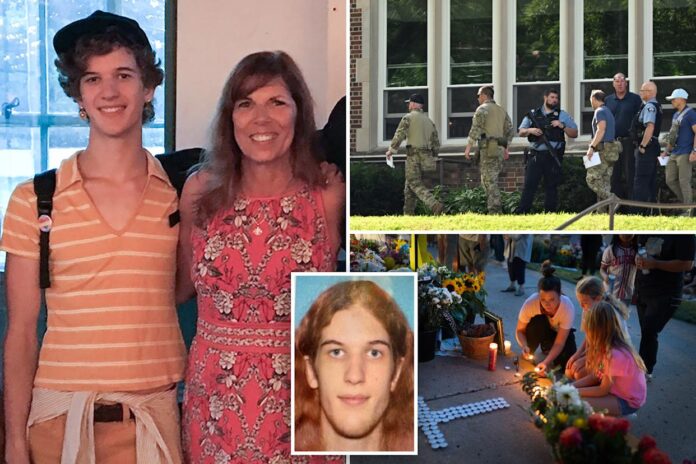“From a quiet kid to a calculated killer: What secrets lie in the complete timeline of the Minneapolis shooter’s life?”
A Catholic school, a shattered community, and a 23-year-old whose chaotic journey ended in tragedy. What turned a former student into a monster? From a broken home to cryptic writings and a chilling plan, the full story will leave you speechless.
👉 Uncover the haunting timeline of Robin Westman’s descent. Click to read now.

Court records show that Mary Grace Westman and her ex-husband, James Westman, divorced in 2012. Robin, then Robert, was 11 at the time and had two older siblings.
The custody agreement showed Mary Grace as his primary caretaker, with his father given custody every other weekend.
Both parents had Minneapolis addresses until at least 2021.
2016: “Criminal offense” at home
Citing police records, NBC reported that local police responded to a “criminal offense” at the suburban Westman home. Further details are scant, but the case was closed.
Jan. 26, 2018: Mental health incident at home
Two years later, police in Eagan, Minnesota, were called to the home, this time for an incident described only as “mental health.”
The incident report noted that Eagan police “assisted Mendota Heights with a check welfare of a juvenile,” according to NBC.
It is unclear who the juvenile in need of a mental health check was.
2019: Westman changes name
Robert Westman became Robin Westman in 2019.
Westman’s mother, Mary Grace Westman, signed off on the name change.
Court documents show the shooter’s mother applied for her son to legally change his name, writing in 2019, “minor identifies as female and wants her name to reflect the identification.”
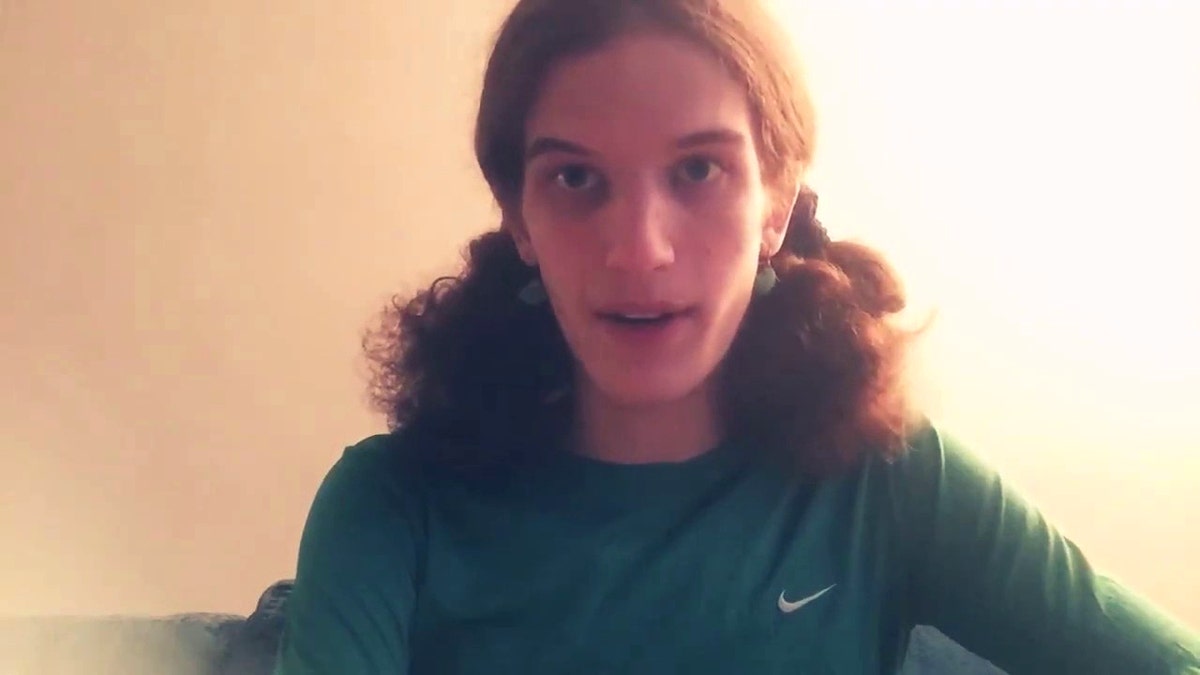
Screenshots from a YouTube video posted by Robin M. Westman, 23, show the suspect police identified as the gunman in the Aug. 27, 2025 Minneapolis church school shooting. (Obtained by Fox News)
2021: Mary Grace Westman retires from job at church
Minneapolis Police Chief Brian O’Hara confirmed that the shooter’s mother worked at the school for several years and retired in 2021.
Summer 2025: Westman moves in with friend
According to a warrant, James Westman told police that Westman had “recently” broken up with a romantic partner.
In that same warrant, the elder Westman told police that the shooter moved in with a friend at the St. Louis Park address that police searched after the shooting.
Neighbors speculated that Westman could have moved into the new location just two weeks prior to the shooting, while some said he moved in earlier this summer.
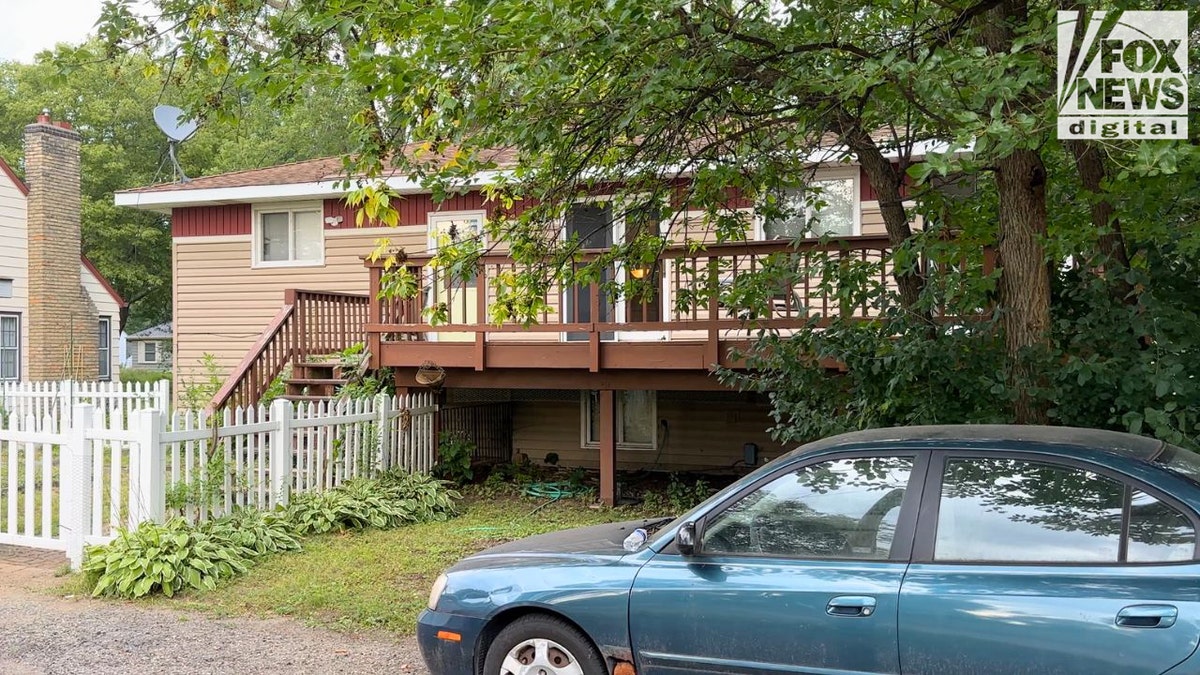
The back and side view of the St. Louis Park rental where Robin Westman is believed to have stayed before the Annunciation School shooting, showing the elevated deck and side entrance. (Michael Dorgan/Fox News Digital)
July and August 2025: Westman scouts location
Westman visited the church in the weeks leading up to the shooting in order to “scout” the location, CNN reported. He had interactions with people there and told them he was trying to reconnect with his faith.
The soon-to-be mass killer may have been to the location more than once leading up to the attack, according to journal writings analyzed by The New York Post.
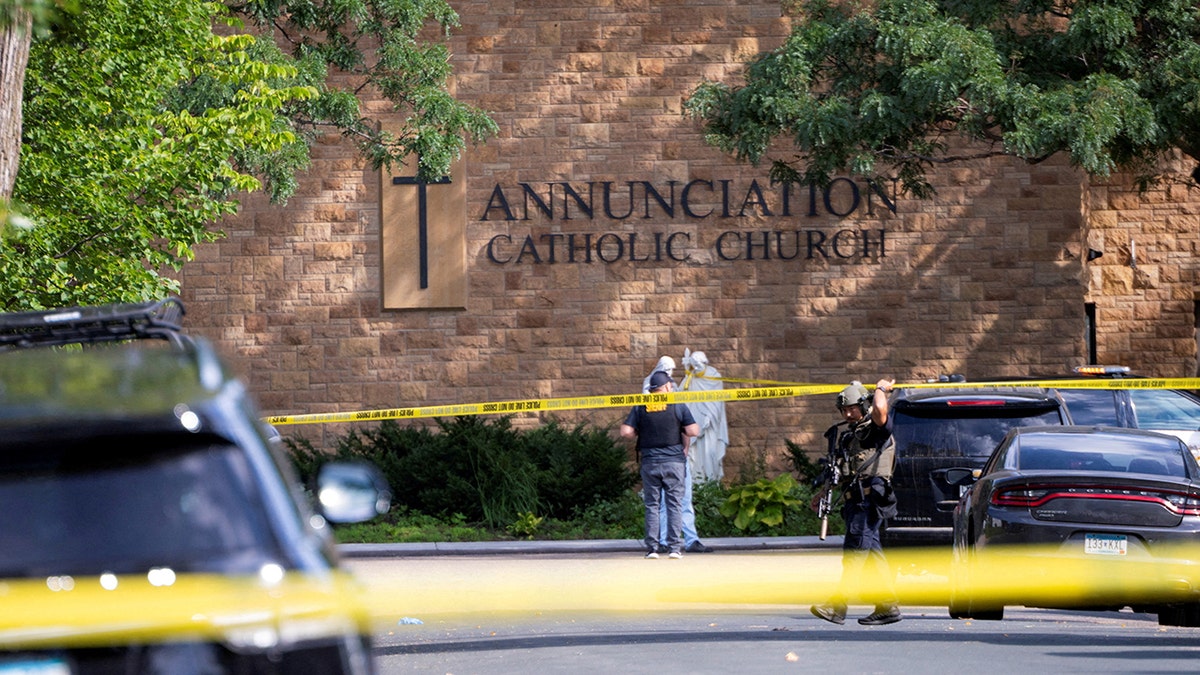
Officers set up barriers after a shooting at Annunciation Church, which is also home to an elementary school, in Minneapolis, Minnesota, on Aug. 27, 2025. (REUTERS/Ben Brewer)
Aug. 16: Westman leaves job at RISE dispensary
According to the Minnesota Star Tribune, Westman left his job at a marijuana dispensary called RISE only 11 days before the shooting.
An unnamed coworker told the paper that he worked as a “personal care specialist” and worked with patients who were part of a state medical marijuana program.
That coworker cryptically said, “recent events have been the catalyst for this thing he has been planning for a long time.”
RISE said in a statement that it was “deeply saddened” by the shooting, and offered condolences to the victims, their families and the community as a whole.
“We have been informed that the individual identified by authorities as the shooter was a former employee of our RISE Dispensary in Minnesota for several months this year,” the company said. This individual was not employed by the company at the time of the incident.”
The company said it is fully cooperating with investigators.
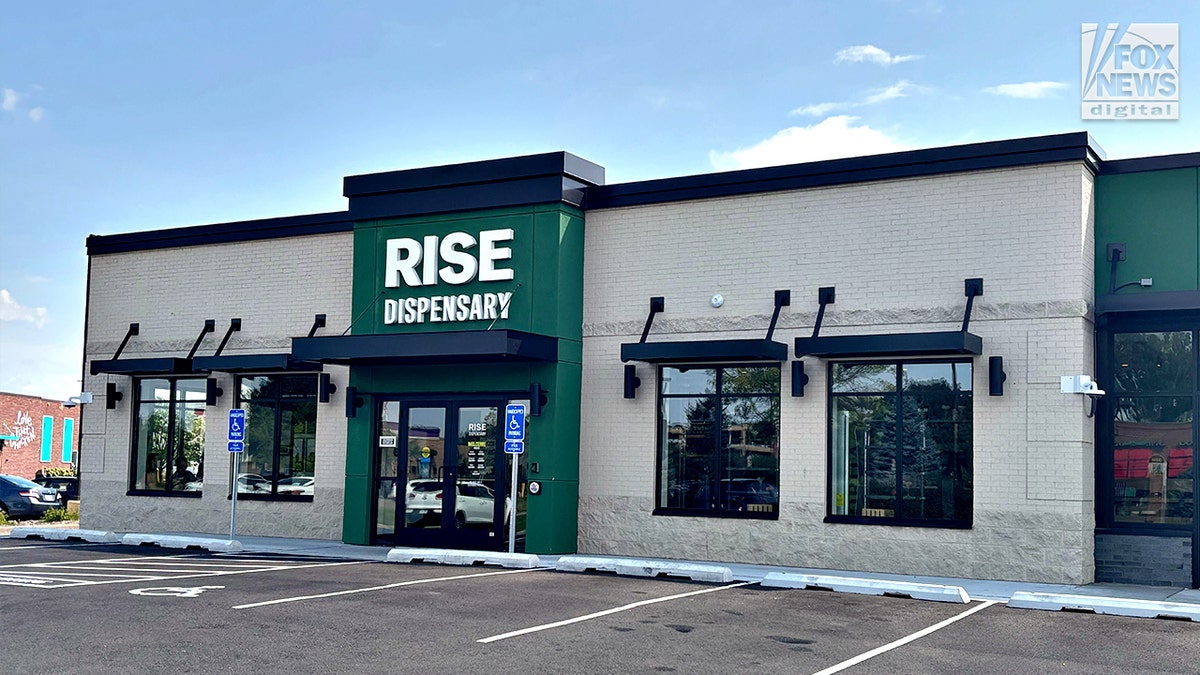
Exterior view of RISE Dispensary in Eagan, Minn., Thursday, Aug. 28, 2025, a cannabis store where the Church of the Annunciation mass shooter, Robin Westman, previously worked. (Michael Dorgan/Fox News Digital)
Aug. 26: Police respond to juvenile welfare check at mother’s Florida home
The day before the shooting, the Collier County Sheriff’s Office responded to a juvenile welfare check at Mary Grace Westman’s Naples, Florida, condo.
Deputies were looking for a child and the child’s mother who they say previously lived with Westman at the home.
“Contact was made with Mrs. Westman who stated the juvenile and the juvenile’s mother had previously lived there and were no longer living with her,” the Collier County Sheriff’s Office told Fox News Digital.
“Deputies later contacted the mother of the juvenile and confirmed the juvenile was okay. This call for service was not related to the incident in Minneapolis or the shooter.”
Morning of Aug. 27: Westman carries out the shooting
Westman opened fire from outside the church just before 8:30 a.m. and fired more than 100 rounds, killing two and injuring 18 others, including 15 children. The shooter wore all black and was found in possession of four firearms.
The doors to the church were locked before mass began, which police said “likely saved countless lives.”
Police arrived on the scene within minutes, and by 9:00 a.m., announced that there was no further threat.
Eight‑year‑old Fletcher Merkel and 10‑year‑old Harper Moyski were later identified as the deceased victims.
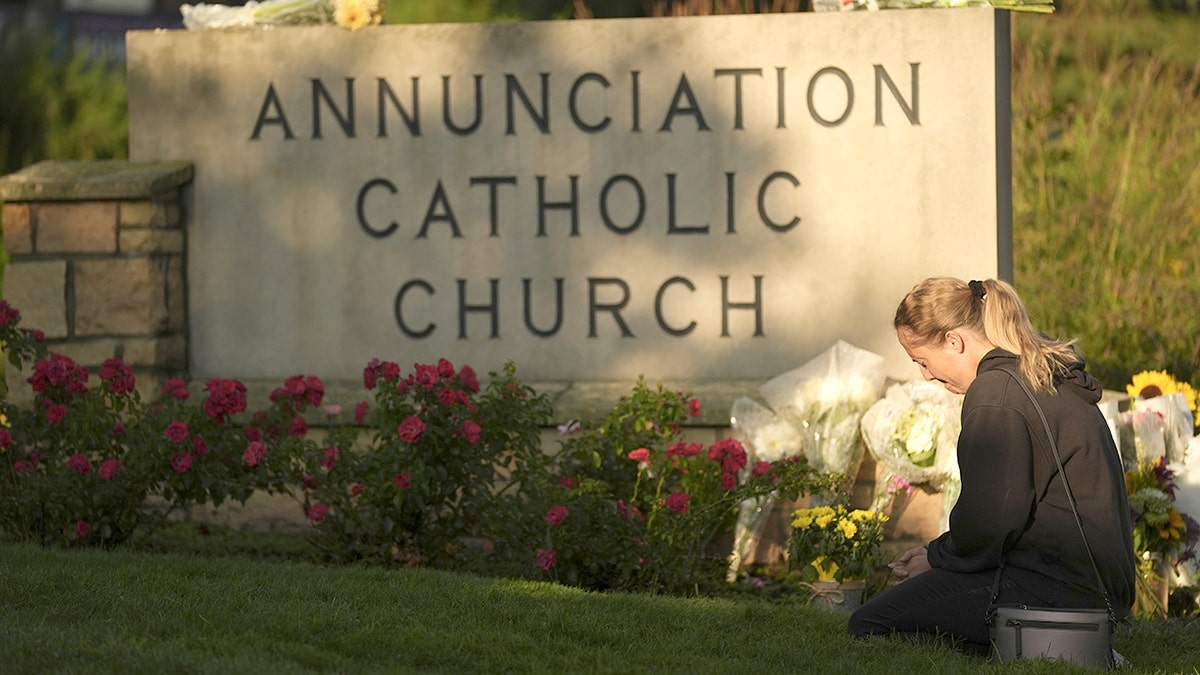
Ann Stovner kneels by a makeshift memorial at Annunciation Catholic Church after Wednesday’s school shooting, Thursday, Aug. 28, 2025, in Minneapolis. (Abbie Parr/AP Photo)
Afternoon of Aug. 27: Police execute search warrants
Later in the day, a search warrant was executed at a St. Louis Park residence where Westman had been staying with a romantic partner until a recent breakup.
Police also made contact with James Westman, the shooter’s father, who confirmed that the shooter drove a minivan police found at the scene.
Afternoon of Aug. 27: FBI visits Mary Grace Westman’s home
The FBI arrived at the Naples condo in the afternoon, though she was not home when agents arrived, according to WINK.
Mary Grace Westman has refused to cooperate with police in the wake of the attack and has hired an attorney.
“She is completely distraught about the situation and has no culpability but is seeking an attorney to deal with calls like this,” attorney Ryan Garry told Fox News.
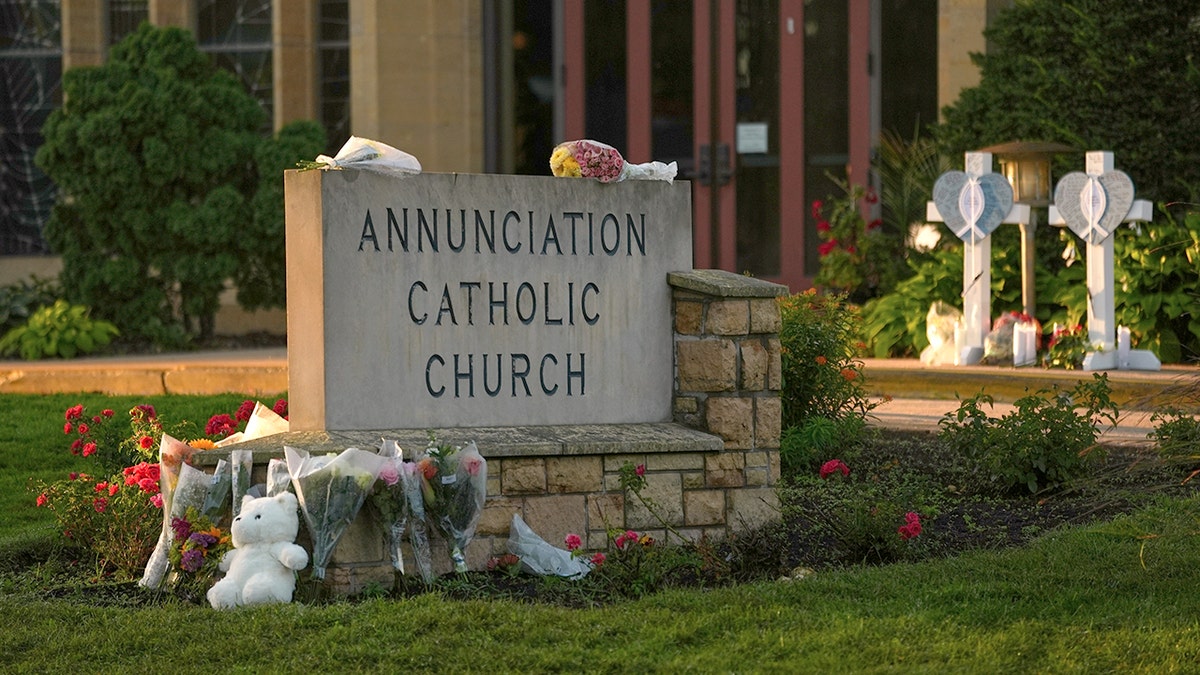
Crosses, flowers and other mementos were placed by the sign at Annunciation Catholic Church at a memorial after Wednesday’s shooting at the school, Thursday, Aug. 28, 2025, in Minneapolis. (Abbie Parr/AP Photo)
While the shooter’s exact motive remains unknown, Acting United States Attorney for the District of Minnesota Joe Thompson said hatred aimed at everyone played a significant role.
“The shooter expressed hate towards almost every group imaginable. The shooter expressed hate towards Black people. The shooter expressed hate towards Mexican people. The shooter expressed hate towards Christian people. The shooter expressed hate towards Jewish people,” Thompson continued. “In short, the shooter appeared to hate all of us. The shooter’s heart was full of hate. There appears to be only one group that the shooter didn’t hate. One group of people who the shooter admired. That group were the school shooters and mass murderers that are notorious in this country.”
The FBI is investigating the mass shooting as a hate crime.
On the morning of August 27, 2025, the Annunciation Catholic Church in Minneapolis, Minnesota, became the site of an unimaginable tragedy. A 23-year-old shooter, identified as Robin Westman, opened fire through the stained-glass windows of the church during a school-wide Mass, killing two children—Fletcher Merkel, 8, and Harper Moyski, 10—and injuring 18 others, including 14 children and three elderly parishioners. The shooter, who died by suicide at the scene, left behind a trail of hate-filled writings, videos, and a meticulously planned attack that has left authorities and the community grappling for answers. This article explores the timeline of events and the chaotic life that led to this devastating act, drawing from available reports while carefully navigating the complexities of motive and ideology.
Early Life and Family Background
Robin Westman, born Robert Westman, grew up in suburban Minneapolis, attending Annunciation Catholic School and participating in services at the adjacent church. The school, established in 1923, is a cornerstone of the Windom neighborhood, known for its faith-based education and tight-knit community. Westman’s mother, Mary Grace Westman, worked in the church’s business office until her retirement in 2021, giving the family a deep connection to the parish. However, beneath this seemingly stable environment, cracks were forming.
Court records reveal that Westman’s parents, Mary Grace and James Westman, divorced in 2012 when Robin was 11 years old. This marked a significant disruption in the shooter’s early life, though details about the family dynamics remain sparse. By 2019, at age 17, Westman legally changed their name from Robert to Robin, with Mary Grace signing off on the change, citing the minor’s identification as female. This transition, while a personal milestone, coincided with a period of increasing instability. Police records indicate a “criminal offense” at the Westman family home in 2019, though the case was closed without further detail. Two years later, in 2021, authorities in Eagan, Minnesota, responded to a “mental health” incident involving a juvenile at the same address, though it’s unclear if this involved Robin.
Signs of Distress and Isolation
As Westman entered their late teens and early twenties, their life appeared to spiral into chaos. Former classmates described Westman as having few friends and displaying “odd obsessions” that, in hindsight, were red flags. One peer, interviewed by a local news outlet, recalled Westman’s fascination with writing in code, possibly to conceal their thoughts. This behavior, coupled with a reported interest in the “true crime community,” hinted at a growing fixation with mass violence. Westman’s social media activity, particularly two YouTube videos posted shortly before the attack, revealed a disturbing obsession with past mass shooters, including names like Adam Lanza, Anders Breivik, and Brenton Tarrant, whose actions Westman referenced in writings and inscriptions on their weapons.
In 2025, Westman briefly worked at a cannabis dispensary in Minneapolis but was no longer employed there at the time of the shooting. A recent breakup with a romantic partner added to their personal turmoil, with police executing a search warrant at a St. Louis Park residence where Westman had been staying. The shooter’s father confirmed that a minivan found at the scene belonged to Westman, further tying them to the attack. These fragments of Westman’s life paint a picture of a young adult struggling with personal and emotional challenges, though no official mental health diagnoses have been publicly confirmed.
Planning the Attack
The attack on Annunciation Catholic Church was not a spontaneous act but the culmination of months of meticulous planning. Law enforcement officials revealed that Westman had visited the church in the months leading up to the shooting, likely scouting the location. The shooter chose a significant moment—the first all-school Mass of the academic year, held on August 27, 2025, at 8:15 a.m.—to carry out the attack. Armed with a legally purchased semiautomatic rifle, pump-action shotgun, and pistol, Westman approached the church dressed in black and fired dozens of rounds through the stained-glass windows. A total of 116 rifle rounds, three shotgun shells, and one malfunctioned handgun round were recovered at the scene.
Westman barricaded the side doors of the church, ensuring that worshippers could not easily escape. However, the church’s protocol of locking its doors after Mass began likely prevented the shooter from entering the building, a measure credited with saving countless lives. The attack was accompanied by a “manifesto” posted on YouTube, which included references to depression, violent thoughts, and apologies to family members. The videos also showcased a notebook with schematic drawings of the church’s interior, indicating a calculated approach to the massacre.
The Attack and Its Aftermath
The shooting began just before 8:30 a.m., as students and parishioners were gathered for the annual Mass marking the start of the school year. Parishioner Cathrine Spandel recalled the moment gunfire erupted, describing how worshippers had just finished a psalm when bullets shattered the stained-glass windows. Adults and older children acted heroically, shielding younger students under pews as chaos unfolded. One injured girl with a head wound was triaged immediately and is expected to survive, a testament to the quick response of first responders.
The two children killed, Fletcher Merkel and Harper Moyski, were sitting in the pews when they were struck. Fletcher’s father, Jesse Merkel, described his son as a lover of family, fishing, cooking, and sports, while Harper’s parents, Michael Moyski and Jackie Flavin, remembered their daughter as a joyful 10-year-old whose laughter touched everyone. The 18 injured victims, including 14 children aged 6 to 15 and three elderly parishioners, were treated at local hospitals, with most expected to recover. Hennepin County Medical Center reported treating 11 patients, nine of whom were students, while Children’s Minnesota handled seven child victims.
The community’s response was swift and heartfelt. Vigils were held at nearby schools, with mourners leaving flowers and crosses at a makeshift memorial outside the church. Minneapolis Mayor Jacob Frey and Minnesota Governor Tim Walz condemned the attack, calling for stronger gun control measures, including bans on assault weapons and high-capacity magazines. Former presidents Joe Biden, Barack Obama, and Bill Clinton expressed their grief, with Biden noting, “No parent should ever have to bury their child.”
Investigating the Motive
Authorities, including the FBI and Minneapolis Police, are investigating the shooting as an act of domestic terrorism and an anti-Catholic hate crime. Writings and inscriptions on Westman’s weapons revealed a deep-seated hatred toward multiple groups, including Black people, Mexican people, Christians, Jews, and even a call for violence against President Donald Trump. Acting U.S. Attorney for Minnesota Joseph Thompson described Westman as someone who “appeared to hate all of us,” with a particular obsession with killing children. However, extremism analysts caution against oversimplifying the motive, noting that Westman’s writings also included a message stating, “There is no message,” suggesting a nihilistic worldview rather than a coherent ideology.
Westman’s fascination with past mass shooters and the “true crime community” points to a troubling trend among young perpetrators who seek notoriety through violence. References to cultural markers within nihilistic extremist spaces, such as “Saints Culture,” which venerates far-right terrorists, further complicate the shooter’s profile. Despite these clues, no specific grievance against the church or school has been identified, leaving investigators to piece together a motive from hundreds of pieces of evidence.
Community and Policy Implications
The shooting at Annunciation Catholic Church has reignited debates about gun violence in the United States, particularly in schools and places of worship. Minnesota, which passed “red flag” laws and universal background checks in 2023, has seen a reduction in mass shootings, but the tragedy underscores the need for further action. Advocates like Mayor Frey and Congresswoman Ilhan Omar have called for bans on assault weapons, arguing that such firearms have no place in civilian hands. The shooting also follows other recent acts of violence in Minneapolis, including the targeted killings of state lawmakers in June 2025, highlighting the city’s ongoing struggle with gun violence.
For the Annunciation community, the road to healing will be long. Principal Matthew DeBoer praised the heroic actions of staff and students, who moved quickly to protect one another. The church’s century-long legacy of faith and service remains unshaken, but the scars of August 27, 2025, will linger. As the investigation continues, the focus remains on supporting the victims’ families and preventing future tragedies.
Conclusion
The Minneapolis Catholic school shooting is a stark reminder of the fragility of safety in places meant to be sanctuaries. Robin Westman’s life, marked by chaos and a descent into violent obsession, culminated in an act that shattered a community.
